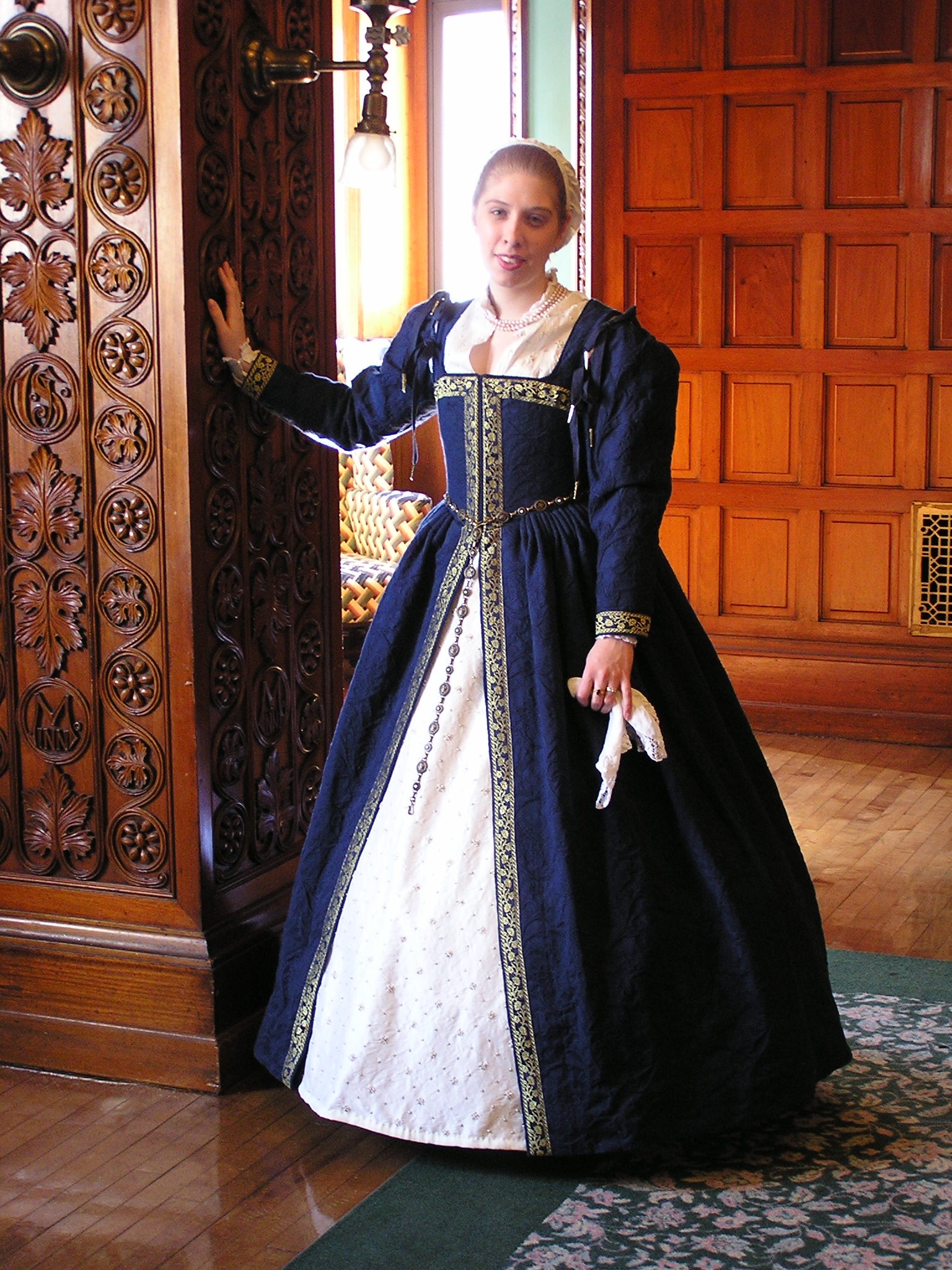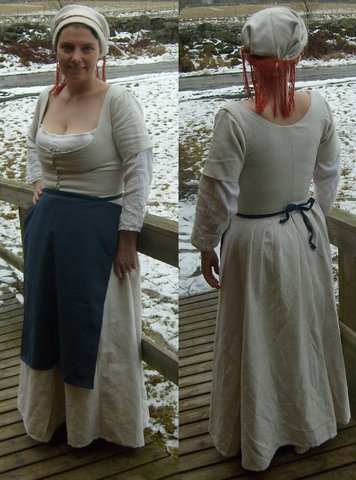Difference between revisions of "Kirtle"
(New page: The kirtle is sort of a general purpose under-dress. In European fashions it is worn over the bodies and pettcoat, and under the gown or over dress. Lower class women wore kirtles...) |
|||
| (15 intermediate revisions by the same user not shown) | |||
| Line 1: | Line 1: | ||
| − | The kirtle is sort of a general purpose under-dress. In European fashions it is worn over the [[bodies]] and [[ | + | [[Image:Kirtlegrey.jpeg|thumb|left]] |
| + | The kirtle is sort of a general purpose under-dress. In European fashions it is worn over the [[bodies]] and [[petticoat]], and under the gown or over dress. Lower class women wore kirtles as an outer dress over their [[chemise]]. Kirtles were part of fashionable attire into the middle sixteenth century, and remained part of country or middle-class clothing into the seventeenth century. [[Image:Basic Elizabethian.jpeg|thumb|Elizabethan style kirtle. It is worn with a [[hoop skirt]], tie on sleeves, a forepanel skirt, petticoats, a partlet and a [[coif]]. She is likely wearing a [[corset]] and [[chemise]] underneath.]] | ||
| − | Kirtles could be loose garments without a waist seam, or could be made as a combined bodice and petticoat, depending on their use and the current fashion. Kirtles typically laced up the back or side-back, especially when worn under front-lacing gowns as in sixteenth century Germany and the Low Countries. | + | In different time periods the kirtle would change shape slightly, but endured as the most consistent item of clothing for women crossing obstacles of class and creed. |
| + | |||
| + | Kirtles could be loose garments without a waist seam, or could be made as a combined bodice and petticoat, depending on their use and the current fashion. Kirtles typically laced up the back or side-back, especially when worn under front-lacing gowns as in sixteenth century Germany and the Low Countries. Kirtles from the 12-14th century typically has short sleeves and were worn with decorative sleeves of a different color and fabric pinned on. | ||
===Links=== | ===Links=== | ||
| + | *[http://cadieux.mediumaevum.com/frontlaced-kirtles.html Excellent instructions and history of kirtles] | ||
| + | *[http://www.mathildegirlgenius.com/Documentation/KASF2006/KirtleWithTrapezoids.pdf 15thc Kirtle instructions] | ||
*[http://www.sempstress.org/patterns/draping/kirtlegored.shtml How to draft a pattern for a Kirtle] | *[http://www.sempstress.org/patterns/draping/kirtlegored.shtml How to draft a pattern for a Kirtle] | ||
*[http://www.elizabethancostume.net/makekirtle.html Constructing a Pattern for a gathered kirtle] | *[http://www.elizabethancostume.net/makekirtle.html Constructing a Pattern for a gathered kirtle] | ||
| − | *[http://www.revivalclothing.com/index.asp?PageAction=VIEWPROD&ProdID=251 purchase 12th cen style linen kirtle] | + | *[http://thescholarsgarret.com/artifact/kirtle/ How to line a kirtle] |
| + | *[http://www.revivalclothing.com/index.asp?PageAction=VIEWPROD&ProdID=251 purchase 12th cen style linen kirtle] (More of an Underdress) | ||
*[http://sca-garb.freeservers.com/articles/corikirtle.html About Kirtles] | *[http://sca-garb.freeservers.com/articles/corikirtle.html About Kirtles] | ||
| − | + | *[https://www.reconstructinghistory.com/rh002-15th-century-womens-kirtle-sleeves.php?s=&c=22&d=29&q=1&p=71&w=21 Pattern of A 15th century kirtle with sleeves] | |
| + | *[http://thescholarsgarret.com/artifact/kirtle/ | ||
[[Category:Garb]] [[Category:Garb Undergarments]] | [[Category:Garb]] [[Category:Garb Undergarments]] | ||
| + | [[Category:European Garb]] [[Category:Women's Garb]] [[Category:Dress]] | ||
Latest revision as of 17:46, 20 April 2009
The kirtle is sort of a general purpose under-dress. In European fashions it is worn over the bodies and petticoat, and under the gown or over dress. Lower class women wore kirtles as an outer dress over their chemise. Kirtles were part of fashionable attire into the middle sixteenth century, and remained part of country or middle-class clothing into the seventeenth century.

In different time periods the kirtle would change shape slightly, but endured as the most consistent item of clothing for women crossing obstacles of class and creed.
Kirtles could be loose garments without a waist seam, or could be made as a combined bodice and petticoat, depending on their use and the current fashion. Kirtles typically laced up the back or side-back, especially when worn under front-lacing gowns as in sixteenth century Germany and the Low Countries. Kirtles from the 12-14th century typically has short sleeves and were worn with decorative sleeves of a different color and fabric pinned on.
Links
- Excellent instructions and history of kirtles
- 15thc Kirtle instructions
- How to draft a pattern for a Kirtle
- Constructing a Pattern for a gathered kirtle
- How to line a kirtle
- purchase 12th cen style linen kirtle (More of an Underdress)
- About Kirtles
- Pattern of A 15th century kirtle with sleeves
- [http://thescholarsgarret.com/artifact/kirtle/
